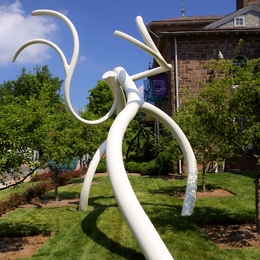
Anyone within view of the James A. Michener Art Museum in Doylestown this summer will be drawn to some captivating new additions to the institution’s grounds: colorful, elegant and even provocative sculptures, each of them suggesting two figures entwined. The forms could be either locked in a passionate embrace or in the throes of mortal combat—or perhaps something in between.
No matter what a viewer sees in the sculptures, their interpretation is correct. So says Steve Tobin, the internationally lauded sculptor who crafted these “Dancing Roots” sculptures and other creations featured throughout the museum’s grounds as part of “Out of this World: Works by Steve Tobin,” an exhibition running at the Michener from June 28 to October 26.
“There are relationships between the figures,” Tobin says of his sculptures skirting the museum’s exterior. “People bring their own experiences to the forms; some people see romance or conflict or resolution. The viewer will fill in the blanks; I’m just trying to stimulate their participation, because that is what makes the work resonate. If I fill in too much, there’s less room for people to bring in their own life experiences.”
“Out of this World” represents a homecoming of sorts for the Quakertown-based Tobin. His work in monumental glass, bronze, steel and clay has been featured in exhibitions and installations not only across the country but also throughout the world, from Canada to Switzerland. The exhibition includes his “Dancing Roots” and “Syntax” sculptures on the building’s exterior and a 15-foot-tall “Steelroots” sculpture within the museum’s Martin Wing, as well as “Exploded Earth” clay vessels and “Forest Floors” bronzes from his “Earth Bronze” series. In addition, an installation of Tobin’s early glasswork will complement the steel, bronze and clay compositions.
Viewers will likely come away from the Tobin exhibition with “a lot of joy and awe,” according to Lisa Tremper Hanover, director and CEO of the Michener, who has worked with Tobin before. In 1995 she curated one of his exhibitions at the Berman Museum of Art at Ursinus College in Collegeville, of which she was then director. When she joined the Michener in 2012, she began mulling the idea of once again showcasing the works of an artist in whom she saw great promise nearly 20 years ago.
“Instead of showing every single medium and genre that Steve has worked in, we will focus this exhibition on specific areas, like his ‘Earth Bronze’ pieces, which are very organic and rarely shown, as well as his exploded clay work, which are so accessible to families and children,” she says. “And of course there will be his massive ‘Steelroots.’ There’s a certain balance in his work that is unique to him. He balances that engineering mind with a very creative aesthetic to transform these objects into incredible forms and shapes.”
Compared to most contemporary artists, Tobin came to his craft with a rather unique background: theoretical mathematics. Although he does express a deep appreciation for Alexander Calder, Andy Goldsworthy and other well-known sculptors who preceded him, not to mention creative minds such as Albert Einstein and Ludwig van Beethoven, it is his closeness to the natural world that most influences his work. His studio rests on his 15-acre property in Quakertown, providing ample space and inspiration for orchestrating the “events” that help him create his outsized works of art.
“I came to art more as a form of expressing myself, not as a livelihood,” he says. “My life has been very connected to nature—the sounds of nature, the light and shadow in the woods—and all those things have impacted my work in that I use them to convey information. I live with a very thin membrane between me and my environment—I make my own maple syrup; I have animals running around my property—and these pieces of mine are icons to nature, distillations from nature.”
Tobin hopes his monumental structures will one day “stand with Stonehenge and Easter Island,” and not just in terms of their impressive size. His “Trinity Root,” a massive installation in Lower Manhattan, has already achieved a certain level of transcendence. This bronze sculpture depicts the stump and roots of a 70-year-old sycamore that shielded St. Paul’s Chapel from debris from the collapsed towers of the World Trade Center during the terrorist attacks of September 11, 2001. Millions of viewers have seen the work, which is permanently displayed at the corner of Wall Street and Broadway.
“I challenge the viewer to say, ‘What does my art look like?’” he says. “My interest is to not fall under anyone else’s shadow. … I design my work outside the fashion of the day to see how it might be relevant 500 years from now. With ‘Steelroots,’ I like to think they would be adopted by many cultures and time periods.”
Photography by Rob Hall


